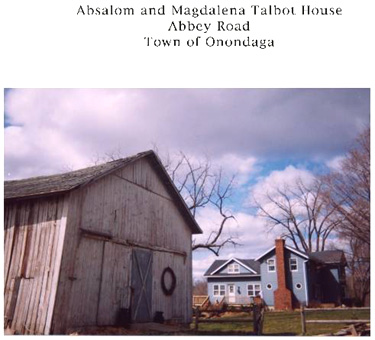

|

Absalom and Magdalena Talbot House
Abbey Road
Town of Onondaga
Mid-nineteenth century
This site represents free people of color who settled in rural areas of Onondaga County, most notably in the Town of Onondaga, and worked as farmers or in skilled trades.
Magdalena Talbot was probably a daughter of Henry Bakeman, a Revolutionary War veteran who settled on the west bank of the Oswego River in what is now Fulton. Many of her siblings also settled in the Town of Onondaga, including Benjamin Bakeman and Oliver Bakeman (Deed, Book ?, Page ?)
Absalom Talbot was a blacksmith and farmer, born in Massachusetts about 1800. He came to Onondaga County about 1810 and bought several pieces of land on lots 178, 179, and 169, beginning in 1835.
In 1850, Absalom and Magdalena Talbot’s household consisted of Absalom, aged 50, who listed his occupation as a blacksmith and who owned property worth $1000; Magdalena, aged 47, and Helen, aged 11.
Absalom Talbot testified in a murder trial in 1854 (Standard, June 19, 1854),
In 1859, he lost at least some of his land, mortgaged to Jacob Bakeman (who may have been his brother-in-law) in a sheriff’s sale.
In 1877, Absalom may have disappeared in mysterious circumstances. Although the following article described William Talbot from South Hollow, this may have been Absalom, since age and occupation are approximately the same:
William Talbot, a colored man whose home is at South Hollow, has been missing since September 22d, when on that night he lodged in the First Ward Station House. He has a wife and niece at home, who are anxious for his return. Mr. Talbot is eighty-four years old, tall, slim, has gray hair and whiskers, and is a mulatto. He has lived in this county for sixty-seven years, is a blacksmith and worked at his trade forty years ago in Geddes. Any information of his whereabouts will be thankfully received by his friends. (Journal, October 1, 1877)
In 1878, Absalom was listed as living in South Onondaga, farming 37 acres of land on lot 169. (Census 1850, deeds, county directory 1878)
Several years later, the Standard published another article about Absalom Talbot:
The Late Absalom Talbot’s Friends in Town. America P. Talbot, Lucius P. Pierce, and Parmenus Pierce, colored men, have come from their homes in Massachusetts to this city, to investigate the disappearance, five y ears ago, of their uncle, Absalom Talbot, who owned a farm in Onondaga Hill. They say that William Abbey, who is in possession of the farm, claims that he bought the property at a Sheriff’s sale but that he did not produce a deed. They think their uncle was put out of the way by foul means. The matter may be given to the Grand jury. Standard, June 5, 1884)
The Tablots were part of a network of a relatively large network of African American families in Onondaga, including the DeGroats and the Days. The 1855 New York State census listed sixty African Americans in the Town of Onondaga, more than in any other town or municipality in Onondaga County except the City of Syracuse.
The Talbot house is located on the west side of Abby Road, just north of the intersection with Makyes Road. Absalom Talbot purchased the first part of this property on Lot 178 on June 17, 1835 from Stephen and Laura Griffin (Deed Book 74, page 125), whose house is stall standing at the intersection of Makyes and Abby Roads. The Talbots ubsequent purchased land on Lots 178, 179 and 169. (See Appendix A: Sites) The Talbot house is shown on 1852, 1860, and 1874 maps of the Town of Onondaga.
As the house stands today, it is a gable-and-wing house with a additional wing at the rear. Patrick Tooley, the current (2002) owner, believes that this rear wing is the oldest part of the house. Blue vinyl or aluminum siding makes it difficult to evaluate the choronology from the exterior. Current assessment data give an 1840 construction date.
The house is currently part of Maple View farm. It is not known how many acres are currently part of this property, but the whole landscape retains an agricultural use. A small stream in a deep ravine flows just north of the house.
A barn just south of the house may date to the historic period.
At least two other houses inhabited by African Americans (members of the Bakeman and DeGroat families) once existed in this neighborhood, along with a cemetery on Makyes Road where some of these families are buried. These houses no longer exist. One site relating to the Day family in the western part of the Town of Onondaga may be an archeological site.
Magdalene’s brother, Jacob Bakeman, may have been giving mortgages to his brothers and sisters in the Town of Onondaga. A search of mortgages would therefore probably yield considerable information.
A search of assessments, which date from 1850 for the Town of Onondaga might reveal dates of construction for various parts of the house.
A complete deed search would also be useful, particularly in sorting out the relationship between William Abbey and Absalom and Magdalena Talbot.
Thanks to Judy Haven for her help in researching this site.
Click on picture to enlarge